February 2006
Microsoft Origami
For quite some time now the likes of Bill Gates, Chuck Thatcher and others have been hinting at some sort of mini version of the Tablet PC. Last year Gates showed a prototype with a 6-inch screen at the Windows Hardware Engineering Conference. Go to the Origami website to find out.... not much. But you will, the Flash presentation promises. On March 6th. -- Posted Tuesday, February 28, 2006
New Sony music/camera Walkman and Cyber-shot phones
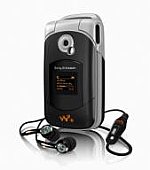 Sony Ericsson has added the quad band EDGE clamshell W300 to its growing line-up of phones carrying the prestigious Walkman name. The lower cost W300 plays high quality music (MP3 and AAC support) from an included 256MB Memory Stick (expandable to 1GB), has an integrated VGA camera, measures just 3.6 x 1.9 x 1 inches and weighs only 3.3 ounces. Talk time is up to almost 10 hours. Get yours in Shimmering White or Shadow Black.
Sony Ericsson has added the quad band EDGE clamshell W300 to its growing line-up of phones carrying the prestigious Walkman name. The lower cost W300 plays high quality music (MP3 and AAC support) from an included 256MB Memory Stick (expandable to 1GB), has an integrated VGA camera, measures just 3.6 x 1.9 x 1 inches and weighs only 3.3 ounces. Talk time is up to almost 10 hours. Get yours in Shimmering White or Shadow Black.
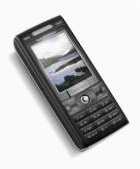 For those who need more serious photographic capabilities, Sony added the Cyber-shot K790 and K800 phones with integrated autofocus 3.2 megapixel cameras. There's a 2-inch TFT, 64MB of memory, Bluetooth, a Memory Stick slot, music and video players, a browser, RSS reader and, oh, UMTS/GPRS (K800) or Tri Band EDGE (K790) phone functionality. -- Posted Tuesday, February 28, 2006
For those who need more serious photographic capabilities, Sony added the Cyber-shot K790 and K800 phones with integrated autofocus 3.2 megapixel cameras. There's a 2-inch TFT, 64MB of memory, Bluetooth, a Memory Stick slot, music and video players, a browser, RSS reader and, oh, UMTS/GPRS (K800) or Tri Band EDGE (K790) phone functionality. -- Posted Tuesday, February 28, 2006
Microsoft unveils Vista lineup; Tablet PC folded into some versions
Microsoft announced the product lineup of its upcoming Windows Vista OS, to be released later this year. The lineup consists of six versions, two for businesses, three for consumers, and one for emerging markets: Windows Vista Business, Windows Vista Enterprise, Windows Vista Home Basic, Windows Vista Home Premium, Windows Vista Ultimate and Windows Vista Starter. Microsft states, "the lineup is designed to deliver clear value to a broad range of customers, each product tailored to meet specific needs of various segments of customers -- home PC users, small and medium-sized businesses and the largest enterprises -- and is aimed at bringing 64-bit, Media Center and Tablet PC functionality into the mainstream." The Business, Home Premium, and Ultimate versions will contain the Windows Tablet PC technology. -- Posted Monday, February 27, 2006
Docs can pick meds covered by health plans on their PDA
Fingertip Formulary announces the launch of Fingertip Formulary Mobile, a real-time wireless solution that provides physicians and other healthcare providers with comprehensive formulary data, including Medicare Part D plans, at the point of care. With a few keystrokes, physicians can now get formulary data at the time they need it using any BlackBerry, Pocket PC, or Palm wireless PDA. Traditionally, physicians have had no simple way to determine which drugs are covered under any of the 10 to 20 health plans in each of their practices.
In a related development, MedPage Today is now also available on wireless Palms, Pocket PCs and BlackBerrys. -- Posted Tuesday, February 21, 2006
Fujitsu unveils Pocket LOOX T830 PPC Phone
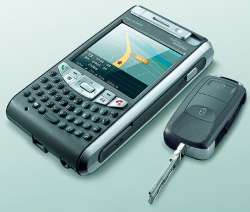 Fujitsu Siemens introduced the Pocket LOOX T830 Pocket PC phone -- a small, handy, versatile Windows 5.0 Phone Edition-based device using a 416MHz version of the Intel PXA270 processor. The T830 has 64MB of RAM, 128MB of Flash, a smallish 2.4-inch 240 x 240 pixel transflective TFT, measures 5.0 x 2.6 x 0.8 inches, and weighs about 6.7 ounces. It's a GSM/UMTS phone with integrated SiRFstar III GPS receiver, WiFi, Bluetooth and a thumbtype keyboard. There's also a 2-megapixel digital camera that can be used to make video phone calls, Voice over IP, and Microsoft Mobile DirectPush email support. Sadly, none of Fujitsu Siemens' impressive lineup of Pocket PCs is sold in the US. [ -- Posted Monday, February 20, 2006
Fujitsu Siemens introduced the Pocket LOOX T830 Pocket PC phone -- a small, handy, versatile Windows 5.0 Phone Edition-based device using a 416MHz version of the Intel PXA270 processor. The T830 has 64MB of RAM, 128MB of Flash, a smallish 2.4-inch 240 x 240 pixel transflective TFT, measures 5.0 x 2.6 x 0.8 inches, and weighs about 6.7 ounces. It's a GSM/UMTS phone with integrated SiRFstar III GPS receiver, WiFi, Bluetooth and a thumbtype keyboard. There's also a 2-megapixel digital camera that can be used to make video phone calls, Voice over IP, and Microsoft Mobile DirectPush email support. Sadly, none of Fujitsu Siemens' impressive lineup of Pocket PCs is sold in the US. [ -- Posted Monday, February 20, 2006
Fujitsu-Siemens #1 in TPC sales in EMEA
According to the Computer to Business Review, Fujitsu Siemens sold over 40,000 Tablet PC in the EMEA last year, a big increase over the preceding year, and, with a 50% marketshare, more than anyone else. Fujitsu Siemen's lineup of Tablet PCs is essentially the same as offered in the US. According to IDC, TPCs amounted to 1.5% of all notebook PCs sold worldwide last year, about a million units, with that number expected to hit almost two million this year. IDC also reported that Toshiba led US Tablet PC sales with a 34% share, followed by HP with 24%. Whether those figures include slates is unclear. According to CBR, upcoming ultramobile Tablet PCs just a bit larger than PDAs should broaden the appeal of TPCs. Our take: Maybe, but so would better digitizers, more pen-centric software, and better hinge mechanisms. -- Posted Monday, February 20, 2006
Kingston Technology reaches $3 billion
Kingston Technnology has reached US$3 billion in 2005 sales as the world's largest independent memory module manufacturer. Key factors in hitting the impressive $3 billion milestone so quickly include ongoing performance increases and a strong focus on developing memory market segments for global production expansion. Over the past few years, Kingston has placed considerable emphasis on its Flash products, its ValueRAM product line of industry-standard memory and also its PC OEM business. Additionally, Kingston's HyperX brand of memory continues to carve deeper inroads into the high-performance gaming/enthusiast market. So congratulations to Kingston Technology, a company whose terrific, reliable products we use every day here at Pen Computing in anything from servers to desktops, notebooks and mobile devices. -- Posted Thursday, February 16, 2006
Good Mobile Defense
Good Technology announced Good Mobile Defense that brings enterprise class security to Windows Mobile Pocket PC and Smartphone, Palm OS, and Symbian handhelds, including third party applications, external storage cards, and handheld features such as WiFi and Bluetooth. With Good Mobile Defense, the level of enterprise security previously only available for GoodLink and GoodAccess is now available to protect the entire handheld. Good Mobile Defense provides advanced password management, application lockdown, feature control, advanced encryption management, and data erase after excessive failed password and authentication attempts. Good Mobile Defense is available as a standalone product and as an extension to GoodLink and GoodAccess for Palm OS handhelds. -- Posted Thursday, February 16, 2006
TI unveils new gen of OMAP processors
While Intel is doing its thing, some other companies have also been delivering processors used in mobile handhelds. Samsung is one, and Texas Instrument another with its OMAP processors. TI now revealed their OMAP 3 multimedia applications architecture. The ARM Cortex A8-based OMAP3430 runs at 550 MHz supports Windows Mobile, Symbian and Linux. Though primarily targetted at mobile handsets, the features seem to make it a powerful and very frugal alternative to the Intel PXA chips. [see TI's detailed description of the OMAP3430] -- Posted Thursday, February 16, 2006
Treo Smartphone of choice for businesses
Palm and Frost & Sullivan today released results of a smartphone end-user survey declaring that the Palm Treo smartphone is the smartphone of choice for businesses. According to the report, mobile professionals are choosing Treo smartphones for the platform's abundant business-ready applications, high degree of flexibility, choice of operating systems, and power and convenience. In addition, Frost & Sullivan assessed the return on investment (ROI) of Treo smartphones used in a range of businesses and conservatively determined the average payback period to be less than two months. The results also reported that sales and field agents experienced productivity gains that equaled $11,125 in average savings per agent each year. [View Frost & Sullivan report as pdf] -- Posted Wednesday, February 15, 2006
Houston, we have a new Palm OS, or do we?
PalmSource and its owner ACCESS Co. announced what they consider the "latest evolution" of the Palm OS at Barcelona's 3GSM World Congress. It's called the ACCESS Linux Platform, or ALP, and is designed to be an integrated, open and flexible Linux-based platform for smartphones and mobile devices. What that means is that the long-awaited Palm OS 6, codenamed Cobalt, will never happen, and Palm OS 5, "Garnet", is gone, at least from ACCESS's plans. That's really not unlike Apple, whose own planned replacement for the legacy original Mac OS was years in the making, just to then be replaced by the totally different OS X when Steve Jobs rode back into power. Anyway, ALP's major components are a standard Linux kernel (version 2.6.12 and higher), the GIMP ToolKit for cool graphics, GSTreamer for multi-threaded media networking, and SQLite, a database for embedded devices. Incorporated also are, surprise, the ACCESS NetFront browser, and a variety of PalmSource messaging, telephony and mobile application components. The ACCESS/PalmSource ALP release includes endorsements and industry support from the likes of NEC, NTT DoCoMo, Samsung, TI, etc., but, interestingly, not from Palm. Our take: This should be interesting. The ACCESS move to Linux was expected. Such a move worked well for Apple, sort of, but with ALP-powered devices not expected until 2007, and with the platform's Japanese origins, it's anyone's guess where Palm itself will place its chips. They may well decide to milk Palm OS 5.4 and then completely switch to Windows Mobile. And with Symbian going very strong and Microsoft's Smartphone gathering steam, it may take Nokia or Sony-Ericsson support to give ALP a chance. -- Posted Tuesday, February 14, 2006
Seagate announces 12GB 1-inch hard drive
Hard drive manufacturer Seagate Technology announced the Seagate ST1.3 Series 12GB 1-inch hard drive. With a footprint 23% smaller, 50% more storage capacity, and 30% less power consumption than Seagate's current 1-inch hard drive, the ST1.3 Series also offers a new optional drop sensor for increased robustness, delivering the features most requested by handheld device manufacturers. Expect this drive to soon show up in a variety of handheld devices. [see release] -- Posted Monday, February 13, 2006
Toshiba's M400 Tablet PC convertible
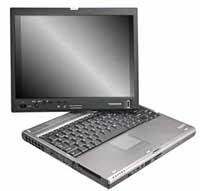 Toshiba released its third generation Tablet PC convertible, the Portege M400. Like its Portege 3500 and M200 predecessors, the new notebook is an ultra-portable. It comes with a 12.1 inch wide-angle viewing XGA display (1400 x 1050 hi-res optional) and weighs just 4.5 pounds. The big news is the inclusion of a media bay that can accommodate the standard CD-RW/DVD drive, a DVD SuperMulti drive, or a second hard drive. Toshiba also upgraded the hardware with Intel's latest trio of Centrino technology components, including a Core Solo T1300 processor and 802.11a/b/g WiFi. The M400 also gets greatly enhanced security, both in the form of shock protection and via the Trusted Platform Module and a fingerprint reader. Prices start at US$1,699. See our detailed preview of the Toshiba M400. -- Posted Friday, February 10, 2006
Toshiba released its third generation Tablet PC convertible, the Portege M400. Like its Portege 3500 and M200 predecessors, the new notebook is an ultra-portable. It comes with a 12.1 inch wide-angle viewing XGA display (1400 x 1050 hi-res optional) and weighs just 4.5 pounds. The big news is the inclusion of a media bay that can accommodate the standard CD-RW/DVD drive, a DVD SuperMulti drive, or a second hard drive. Toshiba also upgraded the hardware with Intel's latest trio of Centrino technology components, including a Core Solo T1300 processor and 802.11a/b/g WiFi. The M400 also gets greatly enhanced security, both in the form of shock protection and via the Trusted Platform Module and a fingerprint reader. Prices start at US$1,699. See our detailed preview of the Toshiba M400. -- Posted Friday, February 10, 2006
RFID-based HealthTrax mobile assets tracking
Healthcare Information Technology specialist InfoLogix announced HealthTrax, their new solution for real-time location tracking and management of medical devices. HealthTrax was developed with InfoLogix partner AeroScout, a leader in Wi-Fi based active RFID solutions. HealthTrax is a complete solution for tracking assets and people within hospitals. It includes both RFID asset tags and enterprise software that can be used with standard wireless networks. The system's benefits are a) asset loss prevention (large hospitals lose hundreds of thousands of dollars worth of equipment each year and spend countless hours searching for patient care assets), b) increased asset utilization (many high-value assets go underutilized, c) patient location tracking (knowledge of patient location helps optimize the patient-care process and critical-care patients particularly benefit from RFID location tracking). [see release] -- Posted Friday, February 10, 2006
EDGE-enabled Cingular 8100 debuts
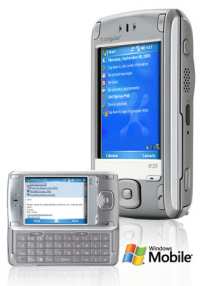 Cingular is adding the HTC-built Cingular 8100 with sliding keyboard to its roster of Windows Mobile 5.0 devices. The device measures 4.3 x 2.3 x 1 inches, weighs 5.25 ounces, has a 2,8-inch QVGA screen, WiFi and Bluetooth, a 200MHz TI OMAP 850 CPU, 64MB RAM and 128MB Flash ROM, Mini-SD, 1.3mp camera (optional version), and a 1250 mAH hour Li-Ion battery. Communication is via quad-band GSM/GPRS/EDGE 850/900/1800/1900. The 8100 will be upgradeable to support the Microsoft Messaging and Security Feature Pack featuring direct push e-mail technology, which is expected to be available in the first half of 2006. The device reinforces the trend towards smaller, lighter Pocket PC phones with smaller displays. It costs US$299 with a two-year contract [see Cingular product page] -- Posted Thursday, February 9, 2006
Cingular is adding the HTC-built Cingular 8100 with sliding keyboard to its roster of Windows Mobile 5.0 devices. The device measures 4.3 x 2.3 x 1 inches, weighs 5.25 ounces, has a 2,8-inch QVGA screen, WiFi and Bluetooth, a 200MHz TI OMAP 850 CPU, 64MB RAM and 128MB Flash ROM, Mini-SD, 1.3mp camera (optional version), and a 1250 mAH hour Li-Ion battery. Communication is via quad-band GSM/GPRS/EDGE 850/900/1800/1900. The 8100 will be upgradeable to support the Microsoft Messaging and Security Feature Pack featuring direct push e-mail technology, which is expected to be available in the first half of 2006. The device reinforces the trend towards smaller, lighter Pocket PC phones with smaller displays. It costs US$299 with a two-year contract [see Cingular product page] -- Posted Thursday, February 9, 2006
Microsoft strengthens global IP protection for device makers
Microsoft announced it will strengthen and broaden intellectual property (IP) protection for original OEMS and distributors that build and sell devices powered by Microsoft Windows Embedded and Windows Mobile software. "Microsoft continues to build out its industry-leading IP protection across markets in response to the changing legal landscape and feedback from its customers and partners indicating that they need to feel secure using Microsoft technology." Our take: With the rapidly emerging industry of companies dedicated solely to sue others for profit via "patent infringement," this is a step Microsoft needed to make, sad though it is. -- Posted Thursday, February 9, 2006
Dedicated mobile computers for automobiles
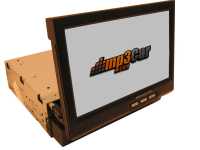 MP3Car has introduced the first hardware that allows a conventional PC to completely replace and surpass the functionality of a conventional car stereo or navigation system. Co-developed with Intel Corporation, the Enabler is the critical "missing link" for car computing, providing all the essential in-car services that PC motherboards lack, including car-quality audio and FM receivers, satellite radio, and hands-free Bluetooth mobile phone integration. MP3Car developed the first complete in-car software platform, StreetDeck, which was recently released at CES 2006. This car computing Enabler completes the puzzle, allowing PC and CE manufacturers to develop hardware systems that integrate perfectly and safely with the car. -- Posted Wednesday, February 8, 2006
MP3Car has introduced the first hardware that allows a conventional PC to completely replace and surpass the functionality of a conventional car stereo or navigation system. Co-developed with Intel Corporation, the Enabler is the critical "missing link" for car computing, providing all the essential in-car services that PC motherboards lack, including car-quality audio and FM receivers, satellite radio, and hands-free Bluetooth mobile phone integration. MP3Car developed the first complete in-car software platform, StreetDeck, which was recently released at CES 2006. This car computing Enabler completes the puzzle, allowing PC and CE manufacturers to develop hardware systems that integrate perfectly and safely with the car. -- Posted Wednesday, February 8, 2006
Apple lowers the price of entry into the iPod universe
Apple introduced a new low-end 1GB iPod nano for just $149. It has the same features as the 2GB and 4GB iPod nano models and holds up to 240 songs or 15,000 photos. The ultra-portable little thing is thinner than a #2 pencil and has the same gorgeous color screen as the other iPod nano models. Apple announced price drops for the iPod shuffle models: the 512MB and 1GB models now cost $69 and $99, respectively. -- Posted Tuesday, February 7, 2006
Pay By Touch Online
Pay By Touch, a provider of biometric authentication, loyalty, membership and payment solutions, announced the launch of Pay By Touch Online, a new payment and identification service that gives consumers a fast, easy and secure way to identify themselves and make purchases on the Internet. Pay By Touch Online is the only solution that increases security and convenience at the same time. The new service is based on Pay By Touch's patented biometric technology. Our take: With more and more Tablet PCs and handhelds including fingerprint scanners, or offering them optionally, pay/identify by touch solutions could become huge both in consumer in vertical markets. -- Posted Monday, February 6, 2006
Reverse evolution: dino Pleo in, doggie Aibo out

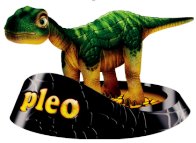 At Pen Computing we've been following all sorts of interesting, future-oriented technologies over the years. Twice we reported on Sony's "Aibo" robot dog experiment. Aibo was a cute US$2,000 mechanical dog that exhibited many canine characteristics and behavioral patterns. However, it just didn't do enough and evolved too slowly, and so Sony, after reportedly having sold 150,000 Aibos in six years or so, terminated the robo-dog project. Interestingly that happened at almost the same date as another company, UGOBE, announced its first "Designer Life Form, Pleo. Pleo is modeled after a 1-week-old Camarasaurus sauropod, or long neck dinosaur, and incorporates basic traits of autonomous life. Pleo has been specifically engineered to mimic life with organic movement and behaviors that allow him to relate to humanity on a personal level." So dog goes, dinosaur comes, supposedly sometimes towards the end of the end, and for less than US$200. No big deal? It may be. The leader of UGOBE's creative team is Furby-creator, Caleb Chung. -- Posted Monday, February 6, 2006
At Pen Computing we've been following all sorts of interesting, future-oriented technologies over the years. Twice we reported on Sony's "Aibo" robot dog experiment. Aibo was a cute US$2,000 mechanical dog that exhibited many canine characteristics and behavioral patterns. However, it just didn't do enough and evolved too slowly, and so Sony, after reportedly having sold 150,000 Aibos in six years or so, terminated the robo-dog project. Interestingly that happened at almost the same date as another company, UGOBE, announced its first "Designer Life Form, Pleo. Pleo is modeled after a 1-week-old Camarasaurus sauropod, or long neck dinosaur, and incorporates basic traits of autonomous life. Pleo has been specifically engineered to mimic life with organic movement and behaviors that allow him to relate to humanity on a personal level." So dog goes, dinosaur comes, supposedly sometimes towards the end of the end, and for less than US$200. No big deal? It may be. The leader of UGOBE's creative team is Furby-creator, Caleb Chung. -- Posted Monday, February 6, 2006
Advertising targets mobile customers
iCrossing, Inc., a marketing company specializing in mobile devices and emerging applications, has launched mCrossing, a dedicated mobile advertising and search service. The new unit allows clients to extend their marketing reach and brand presence with user experiences designed specifically for mobile devices. mCrossing lets clients reach consumers through Mobile Search Optimization and Short Message Services (SMS), among other solutions, that can deliver a variety of informational and marketing content to customers. Beyond receiving simple messages, users can be directed to Internet content that gives an overview of a product or a specific offering to the user such as receiving coupons or movie tickets with barcodes via mobile phones that can be redeemed at the point of purchase. Our take: Commercially supported content has long been a cornerstone in entertainment and other free media, so expect to see much more of it in the near future. -- Posted Monday, February 6, 2006
Another NTP patent gets non-final rejection
Reuters reports that, according to NTP, the U.S. Patent and Trademark Office has issued a non-final rejection of a fifth patent in NTP's legal battle with RIM, a case that threatens to shut down most of RIM's U.S. BlackBerry email service. This means the patent agency has now issued non-final rejections of all five patents at issue in the BlackBerry patent infringement case pending before a federal judge. NTP now has 30 days to respond to the decision, after which the patent office renders a final decision. -- Posted Thursday, February 2, 2006
GPS PDA for real estate agents
Mobile Crossing and Pocket Real Estate are teaming up to provide the industry's first GPS navigation system with functionality designed for Real Estate Agents. Thanks to technology from Pocket Real Estate, Mobile Crossing's new WayPoint Pocket Real Estate Edition combines turn-by-turn spoken directions with complete database access to the agent's multiple listing service out-of-the-box. In addition to providing driving directions to the agent, the WayPoint device doubles as a fully featured Windows Mobile PDA organizer. [See info on the Pocket Real Estate application for Palm and Pocket PC.] -- Posted Thursday, February 2, 2006
FormRouter and Intel's Mobile Forms initiative
FormRouter, Inc. announced new options for users to deploy off-line mobile forms. The new Mobile Forms Technology (MFT), developed through a joint initiative with Intel Corporation, allows mobile professionals to collect data and submit forms while disconnected from the Internet. Submitted forms are preserved in the mobile user's MFM-Outbox until an Internet connection is detected. Once connected, offline form submissions are routed from the mobile desktop to a remote database specified by the form designer/owner. Submitted forms are preserved in the mobile users MFM-Sentbox and may be edited, printed and/or re-submitted at a future date. -- Posted Wednesday, February 1, 2006
Kodak and Sanyo to liquidate OLED display venture
A year or so ago we were very excited to see Kodak's LS633 with a gorgeous, bright 2.2-inch OLED display. OLED, which stands for organic light emitting diode, is a display technology that uses self-luminous pixels that do not require the power-consuming backlights used in LCDs. In order to explore and exploit the technology, Kodak had formed the SK Display joint venture with Sanyo in 2001. While the technology may well replace conventional LCDs initially in phones and small-display devices, SK Displays also showed prototypes of larger versions, such as a 21-inch model in early 2005. Unfortunately, both Kodak and Sanyo are struggling these days, and so decided to call it quits with SK Displays. Kodak PR puts a positive spin on the news, calling it a step towards "promoting the growth of the worldwide OLED industry" as the company will continue to license the promising technology [see release]. Sanyo simply said it will withdraw from the development of advanced flat displays as part of its corporate restructuring efforts. -- Posted Wednesday, February 1, 2006
 Sony Ericsson has added the quad band EDGE clamshell W300 to its growing line-up of phones carrying the prestigious Walkman name. The lower cost W300 plays high quality music (MP3 and AAC support) from an included 256MB Memory Stick (expandable to 1GB), has an integrated VGA camera, measures just 3.6 x 1.9 x 1 inches and weighs only 3.3 ounces. Talk time is up to almost 10 hours. Get yours in Shimmering White or Shadow Black.
Sony Ericsson has added the quad band EDGE clamshell W300 to its growing line-up of phones carrying the prestigious Walkman name. The lower cost W300 plays high quality music (MP3 and AAC support) from an included 256MB Memory Stick (expandable to 1GB), has an integrated VGA camera, measures just 3.6 x 1.9 x 1 inches and weighs only 3.3 ounces. Talk time is up to almost 10 hours. Get yours in Shimmering White or Shadow Black. For those who need more serious photographic capabilities, Sony added the Cyber-shot K790 and K800 phones with integrated autofocus 3.2 megapixel cameras. There's a 2-inch TFT, 64MB of memory, Bluetooth, a Memory Stick slot, music and video players, a browser, RSS reader and, oh, UMTS/GPRS (K800) or Tri Band EDGE (K790) phone functionality. -- Posted Tuesday, February 28, 2006
For those who need more serious photographic capabilities, Sony added the Cyber-shot K790 and K800 phones with integrated autofocus 3.2 megapixel cameras. There's a 2-inch TFT, 64MB of memory, Bluetooth, a Memory Stick slot, music and video players, a browser, RSS reader and, oh, UMTS/GPRS (K800) or Tri Band EDGE (K790) phone functionality. -- Posted Tuesday, February 28, 2006 Fujitsu Siemens introduced the Pocket LOOX T830 Pocket PC phone -- a small, handy, versatile Windows 5.0 Phone Edition-based device using a 416MHz version of the Intel PXA270 processor. The T830 has 64MB of RAM, 128MB of Flash, a smallish 2.4-inch 240 x 240 pixel transflective TFT, measures 5.0 x 2.6 x 0.8 inches, and weighs about 6.7 ounces. It's a GSM/UMTS phone with integrated SiRFstar III GPS receiver, WiFi, Bluetooth and a thumbtype keyboard. There's also a 2-megapixel digital camera that can be used to make video phone calls, Voice over IP, and Microsoft Mobile DirectPush email support. Sadly, none of Fujitsu Siemens' impressive lineup of Pocket PCs is sold in the US. [
Fujitsu Siemens introduced the Pocket LOOX T830 Pocket PC phone -- a small, handy, versatile Windows 5.0 Phone Edition-based device using a 416MHz version of the Intel PXA270 processor. The T830 has 64MB of RAM, 128MB of Flash, a smallish 2.4-inch 240 x 240 pixel transflective TFT, measures 5.0 x 2.6 x 0.8 inches, and weighs about 6.7 ounces. It's a GSM/UMTS phone with integrated SiRFstar III GPS receiver, WiFi, Bluetooth and a thumbtype keyboard. There's also a 2-megapixel digital camera that can be used to make video phone calls, Voice over IP, and Microsoft Mobile DirectPush email support. Sadly, none of Fujitsu Siemens' impressive lineup of Pocket PCs is sold in the US. [ Toshiba released its third generation Tablet PC convertible, the Portege M400. Like its Portege 3500 and M200 predecessors, the new notebook is an ultra-portable. It comes with a 12.1 inch wide-angle viewing XGA display (1400 x 1050 hi-res optional) and weighs just 4.5 pounds. The big news is the inclusion of a media bay that can accommodate the standard CD-RW/DVD drive, a DVD SuperMulti drive, or a second hard drive. Toshiba also upgraded the hardware with Intel's latest trio of Centrino technology components, including a Core Solo T1300 processor and 802.11a/b/g WiFi. The M400 also gets greatly enhanced security, both in the form of shock protection and via the Trusted Platform Module and a fingerprint reader. Prices start at US$1,699.
Toshiba released its third generation Tablet PC convertible, the Portege M400. Like its Portege 3500 and M200 predecessors, the new notebook is an ultra-portable. It comes with a 12.1 inch wide-angle viewing XGA display (1400 x 1050 hi-res optional) and weighs just 4.5 pounds. The big news is the inclusion of a media bay that can accommodate the standard CD-RW/DVD drive, a DVD SuperMulti drive, or a second hard drive. Toshiba also upgraded the hardware with Intel's latest trio of Centrino technology components, including a Core Solo T1300 processor and 802.11a/b/g WiFi. The M400 also gets greatly enhanced security, both in the form of shock protection and via the Trusted Platform Module and a fingerprint reader. Prices start at US$1,699.  Cingular is adding the HTC-built Cingular 8100 with sliding keyboard to its roster of Windows Mobile 5.0 devices. The device measures 4.3 x 2.3 x 1 inches, weighs 5.25 ounces, has a 2,8-inch QVGA screen, WiFi and Bluetooth, a 200MHz TI OMAP 850 CPU, 64MB RAM and 128MB Flash ROM, Mini-SD, 1.3mp camera (optional version), and a 1250 mAH hour Li-Ion battery. Communication is via quad-band GSM/GPRS/EDGE 850/900/1800/1900. The 8100 will be upgradeable to support the Microsoft Messaging and Security Feature Pack featuring direct push e-mail technology, which is expected to be available in the first half of 2006. The device reinforces the trend towards smaller, lighter Pocket PC phones with smaller displays. It costs US$299 with a two-year contract [
Cingular is adding the HTC-built Cingular 8100 with sliding keyboard to its roster of Windows Mobile 5.0 devices. The device measures 4.3 x 2.3 x 1 inches, weighs 5.25 ounces, has a 2,8-inch QVGA screen, WiFi and Bluetooth, a 200MHz TI OMAP 850 CPU, 64MB RAM and 128MB Flash ROM, Mini-SD, 1.3mp camera (optional version), and a 1250 mAH hour Li-Ion battery. Communication is via quad-band GSM/GPRS/EDGE 850/900/1800/1900. The 8100 will be upgradeable to support the Microsoft Messaging and Security Feature Pack featuring direct push e-mail technology, which is expected to be available in the first half of 2006. The device reinforces the trend towards smaller, lighter Pocket PC phones with smaller displays. It costs US$299 with a two-year contract [

 At Pen Computing we've been following all sorts of interesting, future-oriented technologies over the years. Twice we reported on Sony's "Aibo" robot dog experiment. Aibo was a cute US$2,000 mechanical dog that exhibited many canine characteristics and behavioral patterns. However, it just didn't do enough and evolved too slowly, and so Sony, after reportedly having sold 150,000 Aibos in six years or so, terminated the robo-dog project. Interestingly that happened at almost the same date as another company,
At Pen Computing we've been following all sorts of interesting, future-oriented technologies over the years. Twice we reported on Sony's "Aibo" robot dog experiment. Aibo was a cute US$2,000 mechanical dog that exhibited many canine characteristics and behavioral patterns. However, it just didn't do enough and evolved too slowly, and so Sony, after reportedly having sold 150,000 Aibos in six years or so, terminated the robo-dog project. Interestingly that happened at almost the same date as another company,